Posted by Kristen Goodhue on September 6th, 2011
by Kristen Minogue
Tidal marshes have long been lauded as carbon sinks for their ability to pull CO2 from the atmosphere and bury it in the soil, what scientists have taken to calling “blue carbon.” But wetlands are also notorious methane emitters. Now ecologists suspect that only a select few wetland types can reliably act as sinks, and that number may shrink as sea levels rise.
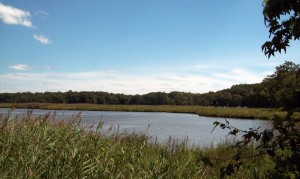
The Kirkpatrick Marsh on SERC's campus in Edgewater, MD. Tidal wetlands both store and release greenhouse gases. Which will prevail as the planet warms is a question ecologists are still trying to answer. (Credit: Gary Peresta/SERC)
Scientists estimate wetlands are responsible for anywhere from 15 to 45 percent of all methane emissions – a wide range that makes predicting their role in climate change difficult. However, that role could prove critical in the years to come. Methane (CH
4) is a far more potent greenhouse gas than carbon dioxide. Over the course of a century, a single gram of methane is roughly 25 times more powerful than a gram of CO
2.
Click to continue »
Posted in Climate Change, Ecology, Interns, Publications | 2 Responses »
Posted by Kristen Goodhue on August 19th, 2011
This summer the SERC interns had a unique addition to their ranks – Iraq veteran Kiel Edson, a former Marine finishing his last year of undergrad at California State University, Sacramento. In this edited Q&A, the 28-year-old shares thoughts on Iraq, SERC and the transition from soldier to researcher.

After five years working as a Russian linguist for the Marines, 28-year-old Kiel Edson started college and discovered his passion for conservation biology. (Credit: Michael Tobias.)
What kind of work did you do for the Marines in Iraq?
E: I was part of a group of what’s called Signal Support Team. We basically go out onto missions off the base, closer to the main cities, and we collect intelligence on what’s happening within the city. And then anything relevant that we find, we basically just write-up in situation reports or intelligence reports and send them off to the commanders who are making decisions as to how to handle the situations in that city. We just tell them, hey, they know that you’re going to ambush, or they know about the convoy going through on Thursday, so that they can change the way that they operate to avoid taking casualties, or they know going in there’s going to be a firefight, so everybody’s prepared for it. It’s not a surprise.
Click to continue »
Posted in Ecology, Interns, Interviews, Invasive Species, Land Use | 1 Response »
Posted by Kristen Goodhue on August 17th, 2011
by Kristen Minogue

Intern Ginny Leviton (left) and Vienna Saccomanno sample groundwater from a drainage ditch, trying to pin down the exact spot where the nitrogen goes missing. (Credit: Tom Jordan)
The Choptank watershed has SERC researchers baffled. On the eastern shore of Chesapeake Bay, roughly a 75-minute drive from SERC, the groundwater flowing into the Choptank River passes through a cornfield – a likely source of nitrogen, a nutrient that can wreak havoc on the Bay’s ecosystem if it runs too high. But something is happening to the nitrogen here before it reaches the Bay. Nutrient ecologist Tom Jordan and his research team have spent the better part of a year trying to figure out what.
Click to continue »
Posted in Ecology, Fisheries, Interns, Land Use, Publications, Water Quality | 6 Responses »
Posted by Kristen Goodhue on July 19th, 2011
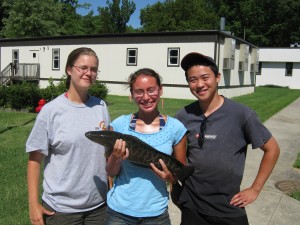
Students on the SERC sampling team, with the 23-inch female snakehead fish they helped ensnare: Diana Sisson (intern), Alison Everett (visiting student), and Philip Choy (intern).
It was around 3 p.m., and it was time to pull the last seine net of the day. We had been out on the water since 10 a.m., and we had already caught a few rarer species, including a stingray and a few juvenile Common Carp. Research biologists Eric Bah and Stacey Havard volunteered to pull what may be the seine of their career.
Click to continue »
Posted in Ecology, Interns, Invasive Species, Publications | 4 Responses »
Posted by Kristen Goodhue on July 19th, 2011
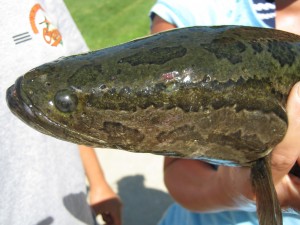
The Northern Snakehead recently crossed into the Rhode River, marking its first appearance in this part of the Bay. Previously scientists thought the Bay's high salinity would hold them in the Potomac, but influxes of freshwater may have smoothed their way.
On the afternoon of Thursday, July 14th, a team of researchers and interns in SERC’s marine invasions lab went out on a routine seining survey in the Rhode River and returned with a troubling catch: a Northern Snakehead fish.
The Northern Snakehead (Channa argus) is a top-level predator that can consume fish and animals up to a third of its body size. It also has the ability to breathe out of water for up to four days if kept moist, using air chambers above its gills that can act as a primitive lung. (But reports of it walking on land are myths. They can at best wriggle short distances, and only juvenile fish have that ability.) More disturbing, at least to ecologists, is their ability to seriously disrupt the food chain wherever they establish themselves.
Native to China, the Northern Snakehead first appeared in Maryland in 2002, in a Crofton pond about 20 miles east of D.C. Regulators moved quickly to eradicate them, but two years later, they established themselves in the Potomac River. Since snakeheads thrive in freshwater (they typically cannot tolerate salinities higher than 15 parts per thousand), it was thought they would be unable to expand beyond the Potomac. But ecologists suspect an influx of freshwater into Chesapeake Bay could have paved the way for them to leave the Potomac and invade other tributaries, such as the Rhode River.
Important note: It is illegal to own or move a Northern Snakehead in the state of Maryland. If you do catch one, the Department of Natural Resources requests that you promptly dispatch it (freezing recommended) and contact the Maryland or Virginia DNR. Though some also suggest cooking it for dinner.
-by Kristen Minogue
See also: Narratives from two interns on the sampling team
Posted in Ecology, Interns, Invasive Species | 2 Responses »
Posted by Kristen Goodhue on July 12th, 2011
by Kristen Minogue

Ali Kishwar, a volunteer tourist from Pakistan, navigates the muddy terrain across from SERC’s beaver pond with caution. (Credit: SERC)
For most people, summer vacation means stretching out on a beach in the South Pacific, touring the ruins of ancient Greece, or (for the more outdoors-inclined) hiking the Inca Trail in Peru. It does not usually entail wading through ankle-deep mud to measure the diameters of trees.
Paul Smith, a 63-year-old retired engineer, travelled to SERC all the way from the United Kingdom to do it. So did Ali Kishwar, a Pakistani doctorate student who took a break from studying medicinal plants at the University of Reading in Berkshire, also in the U.K. Smith and Kishwar joined a motley group of seven citizen scientists who paid to spend a week at SERC doing field work.
Click to continue »
Posted in Climate Change, Ecology, Publications, SERC Sites and Scenes | Comments Off on Grimy field work? Give it to the tourists.
Posted by Kristen Goodhue on May 16th, 2011

Architect\’s image of new Mathias Lab, complete with rain cistern on porch and wetlands to the left. (Credit: EwingCole)
Sustainable houses and office buildings have seen their popularity surge in recent years. But creating a more sustainable laboratory, especially one with chemistry research, where fume hoods can consume up to three times as much energy as an average home, is a bit more of a challenge.
Click to continue »
Posted in Classes and Events, SERC Sites and Scenes | 8 Responses »
Posted by Kristen Goodhue on April 25th, 2011
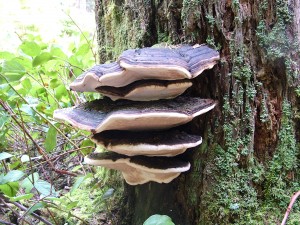
Research suggests some species in the tropics and subtropics may be more resistant to climate change than species closer to the poles. (Credit: SERC)
The threat of radical climate change has made predicting the future of biodiversity a critical challenge for scientists. However, untangling the many intricacies of how climate can affect plant and animal species can also be quite daunting. SERC ecologist Sean McMahon and co-authors, including three Nobel Laureates from the U.N. IPCC report, tackle the issue in a
paper published this month in
Trends in Ecology and Evolution. Broken down, here’s what we already know about biodiversity and climate, what we still need to know, and what to do next.
Click to continue »
Posted in Climate Change, Ecology, Publications | Comments Off on Climate Change & Biodiversity: What’s Next?
Posted by Kristen Goodhue on April 22nd, 2011
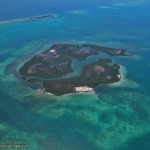
Aerial view of Mangal Cay in the western Caribbean – just one of many mangrove havens Ilka Feller has explored.
As global temperatures rise, mangrove forests from the southeastern US are pushing farther north. Scientists don’t know how long, how fast, or what the exact consequences will be, but images from NASA satellites – and $1.3 million – will help them find out.
Ilka Feller, senior ecologist at the Smithsonian Environmental Research Center, will lead the effort to track more than 100 miles of Florida mangrove forests encroaching on their northern neighbors, the salt marshes. Feller has been studying mangroves for almost 20 years, keeping tabs on their progress in Florida, Panama, Belize and Australia. The new grant is one of 15 NASA-sponsored projects that will combine satellite data with field work to give scientists a bird’s-eye view of climate change.
Click to continue »
Posted in Climate Change, Ecology, Grants, Invasive Species, Mangrove Tracking: Letters from the Field | 2 Responses »
Posted by Kristen Goodhue on April 15th, 2011

A bacterium called Desulfovibrio desulfuricans strain ND132 can transform elemental mercury into methylmercury, a human neurotoxin. Credit: Oak Ridge National Laboratory.
A newly decoded bacterial genome brings scientists one step closer to unlocking the secret behind the production of methylmercury, the chemical notorious for contaminating tuna and other seafood.
Click to continue »
Posted in Publications | Comments Off on New Genome Helps Crack Methylmercury Code
Tags: Chesapeake Bay, Mercury, Microbiology, Pollution, Toxins











